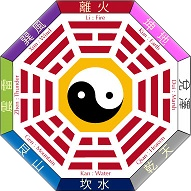
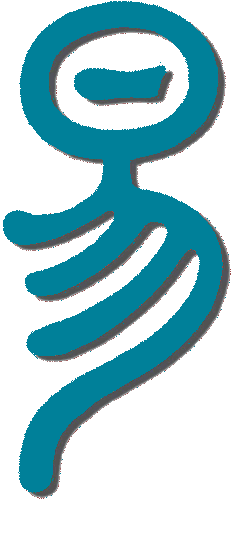
I Ching Explorer

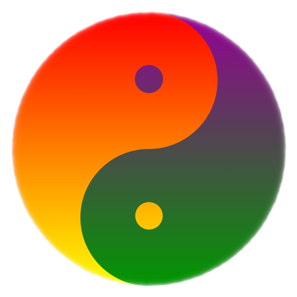
-
☯I Ching Basics
-
☯Consulting I Ching
-
☯Chinese Zodiac
-
☯I Ching Resources
-
If you like our web site and find it useful - donate with PayPal to support new development

Join our free I Ching Google Group. Ask your questions, get the answers from I Ching experts, learn new things about I Ching and grow with our I Ching Community
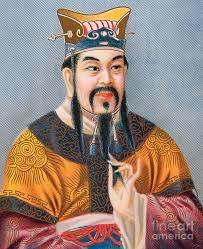
Gua Transformations
New Hexagram Groups
In this section we will discuss new groups of hexagram transformations, applicable to each of 64 I Ching hexagrams.
Based on modern hexagram transformation discoveries, these transformations take to the new level the innovative work in modern
hexagram transformation techniques started by Stephen Karcher ([4]) with his flip
and flip-with-inverse transformations and Mondo Secter’s
evolutional hexagrams method [2].
Discussed below additional new transformations, which aim to further advance the arsenal of modern transformation techniques,
have been first introduced by us in 2005 during our hexagram transformations research and are being first time discussed here.
The foundation of these hexagram transformation techniques rests on mentioned above rotate, evolutional, swap,
flip, flip-with-inverse operators consistently applied now on all three structural levels of hexagram:
single-lines (monograms), digrams- and trigrams- level.
⚋ Monogram-based Transformations
In Hexagrams section of this web portal we have discussed the transformation technique
with rotate operator and how it can be used over the primary hexagram.
However two other important transformation techniques which can be efficiently applied on the monogram level of every hexagrams -
the monograms flip-, flip-with-inverse and swap- operators
have not been discussed so far (or at least could not be found) in I Ching literature.
Monogram-Level Flip-Swap
In this hexagram transformation technique the 1st and 6th lines in the hexagram exchange their places:
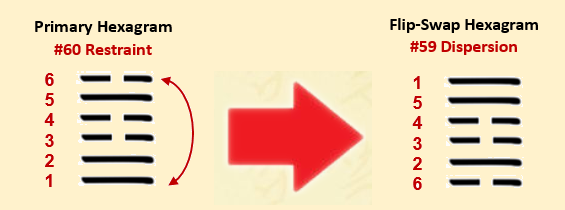
This hexagram transformation creates a new, unique situation around primary hexagram, where beginning (1st line) and end (6th line) exchanged their positions.
What was a beginning, an inception point of primary hexagram is now the end of new hexagram’s time line.
Conversely, the exit, the culmination point of primary hexagram becomes the inception point now.
This flip-swap transformation symbolizes the return, a cyclic development around the kernel of primary hexagram
and can have both a positive or negative meaning for this situation, depending on nuclear hexagram.
Note that this transformation doesn’t affect a nuclear hexagram as lines 1sth and 6th always get excluded from nuclear hexagram forming process.
Note also, that flip transformations are always identical to the swap transformations at the monograms level.
As we will see later, it is not true for digrams- and trigrams- level transformations where the flip- and swap
operators produce different hexagrams.
Monogram-Level Flip-with-Inverse
This hexagram transformation can be considered as a further extension of previously discussed flip operator,
where additional inversion gets applied now to each of two transforming lines.
The 1st and 6th lines in primary hexagram exchange their places with inverting themselves on-the-fly
to Yin-Yang opposites:
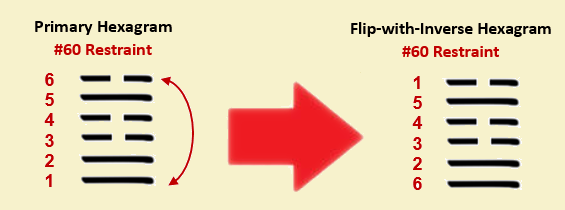
It's interesting to note, that in particular case of hexagram #60, due to original inversed symmetry of lines 1 and 6,
the transformed flip-with-inverse hexagram will be the same as the original one.
In the broader context of all 64 hexagrams in I Ching, this example highlights a special group of hexagrams, whose top and the bottom lines
are the polar inversions of each other, which exhibits a special invariance to flip-with-inverse transformations – they remain the same.
Also, similar to discussed above flip-swap transformation, a flip-with-inverse transformation if applied at the monogram level
doesn’t affect a nuclear hexagram as lines 1sth and 6th always get excluded from nuclear hexagram forming process.
In a more general, phylosophical sense, a flip-with-inverse transformation symbolizes
the turm-around move with abrupt change, a cyclic development around the kernel of primary hexagram with inversion of
polarity for entry and exit points of hexagram.
Monogram-Level Transformations Summary
Adding discussed in this section three new transformation techniques to the pool of existing five monogram-based transformations
we will get the following group of 8 transformed hexagrams
- Nuclear hexagrams
- Inversed Opposite hexagrams
- Reversed Opposite hexagrams
- Rotated hexagrams
- Evolutional hexagrams
- Swap hexagrams
- Flip hexagrams
- Flip-with-Inverse hexagrams
orbiting around the primary hexagram 0
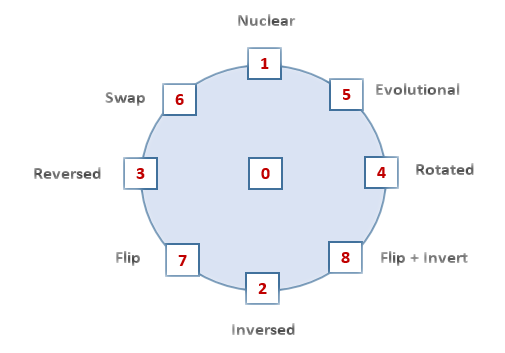
⚍ Digram-based Transformations
A common feature of all transformations in this group is that they apply to the digrams
as the individual building / structural blocks of hexagrams. Digrams can be rotated, evolved, swapped, flipped and
flipped-with-inverse producing new hexagrams related to their primary one.
- Digram Rotate
- Digram Evolutional
- Digram Swap
- Digram Flip
- Digram Flip-with-Inverse
Digrams-Rotate
In this transformation a top digram (Heaven) of primary hexagram moves to its bottom (Earth),
shifting the bottom and middle digrams of primary hexagram one step up.
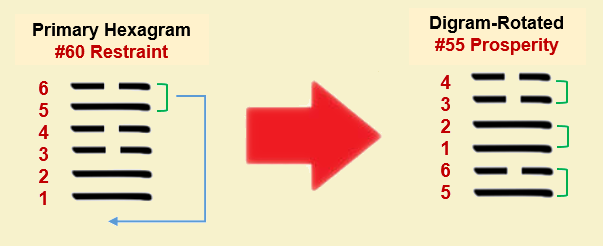
In I Ching symbolism this transformation means “Placing Heaven below the Earth”.
Note, that a middle digram of primary hexagram (lines #3 and #4), which symbolize Mankind, are now on the top position. What is a possible meaning of it? This might refer to the situations where Humans start playing not typical for them roles trying to replace infinite Wisdom of Heaven with limited human capabilities.
Note also, that applied 3 consecutive times to any hexagram a digram-rotate operator returns a hexagram back to itself.
Digrams-Evolutional
Digram evolutional transformation can be considered as a digram-rotate transformation with simultaneous logical inversion of upper digram as a whole.
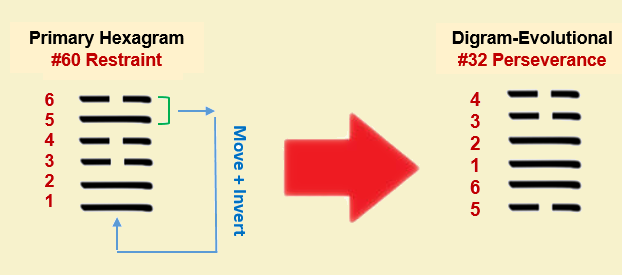
This transformation can be considered as a “traditional” single-line-evolutional transformation applied to primary hexagram 2 subsequent times.
At the divination level this transformation signifies a bigger change than just rotation, as top digram (Heaven) not only moves to the bottom,
but also changes now to its opposite.
Digrams-Swap
In this transformation top digram (Heaven) and bottom digram (Earth) exchange their positions: what was the Heaven becomes the Earth and what was the Earth becomes the Heaven.
Note, that in this transformation each digram gets moved as a whole and the line positions inside each swapped digram are not being affected.
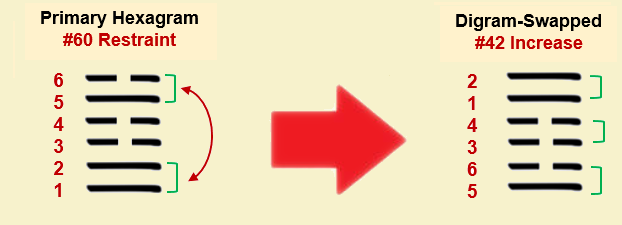
As in I Ching symbolism Heaven has a tendency to move up when Earth – to move down, the middle digram – Mankind - becomes
a focal point of two opposite movements, playing the main balancing role in this change.
In general, this transformation symbolizes a critical change with Man-in-the-Middle (middle digram) providing the main balancing power.
Digram-Flip Transformation
This transformation is made of two independent, sequential groups of changes:
- Two lines in a top digram exchange their positions – line #5 becomes #6 and line #6 becomes line #5. The similar transformation applies to the bottom digram – line #1 becomes line #2 and line #2 becomes line #1.
- Once the step 1 transformation is completed, the Top and the Bottom digrams exchange their positions like in swap transformation above.
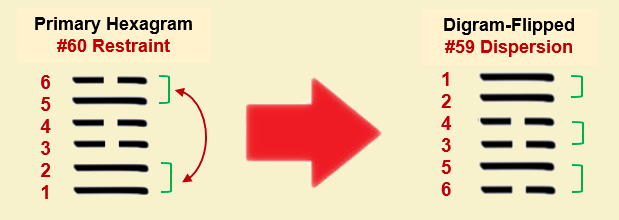
Flip transformation symbolizes radical changes in situation described by primary hexagram.
The examples of these changes could be the instability in society, collapses of governments, the upside-down changes in economy and so on.
Like in swap transformation above, the middle digram – Mankind – in the flip transformation is the main focal point of all changes induced by the digram-flip operation.
Digram-Flip-with-Inverse Transformation
This transformation is made of three independent, sequential groups of changes:
- Two lines in the top digram – lines #5 and #6 - change their polarity to opposite with Yin becoming Yang and Yang becoming Yin. The similar transformation applies to the bottom digram – lines #1 and #2 invert their polarities.
- Once the step 1 is completed, two lines in a top digram exchange their positions – inverted line #5 becomes #6 and inverted line #6 becomes line #5. The similar transformation applies to the bottom digram – inverted line #1 becomes line #2 and inverted line #2 becomes line #1.
- In this final step, already inverted and flipped Top and Bottom digrams as a whole exchange their positions like in swap transformation above.
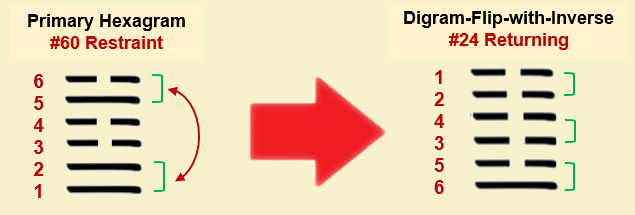
Note that, in this transformation moving digrams not only change their positions – they change their polarity too, transitioning to their own opposite digrams!
This transformation symbolizes sharp revolutionary changes (both good and bad) in situation described by primary hexagram.
It could be, for example, critical instability in society during the change, collapses or forceful replacements of governments,
upside-down changes in economy like depression or recession and so on.
Conversely, it can be noticeable improvements in society, creating clean and corruption-free governments, significant advancements in economy,
like going out of recession and so on.
Similar to the swap and flip digram transformations above, the middle digram – Mankind – is the main focal point
of all changes induced by this digram-flip-with-inverse change.
☲ Trigram-based Transformations
A common feature of all transformations in this group is that they apply to the trigrams
as the individual structural blocks of hexagrams. Similar to digrams, all trigrams can be rotated, evolved, swapped, flipped and
flipped-with-inverse transformed producing new hexagrams related to their primary one.
There are five modern transformation techniques applicable on trigram level of each hexagram:
- Trigram Rotate
- Trigram Evolutional
- Trigram Swap
- Trigram Flip
- Trigram Flip-with-Inverse
Trigrams-Rotate Transformation
Trigrams-Rotate Transformation elevates to the new level the transformation process
started in its digrams-rotate counterpart.
Both transformations highlight the process of significant change in situation denoted by primary hexagram - “what was in the top” rests
now in the bottom, and “what was in the bottom” – takes now a leading position on the top.
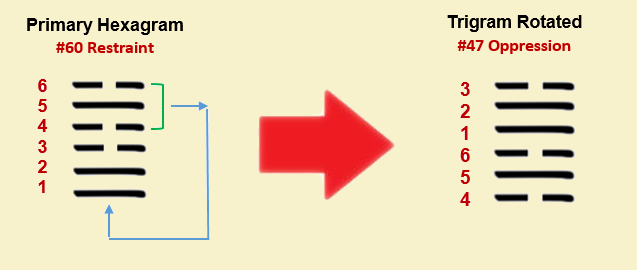
Radical change - both good and bad omen can be associated with this upside-down transformation, depending on specific
trigrams occupying lower and upper positions in hexagram.
Trigram-Evolutional Hexagrams
Trigram-Evolutional Transformation can be interpreted as a trigram-rotate transformation discussed above with simultaneous logical inversion of upper trigram as a whole.
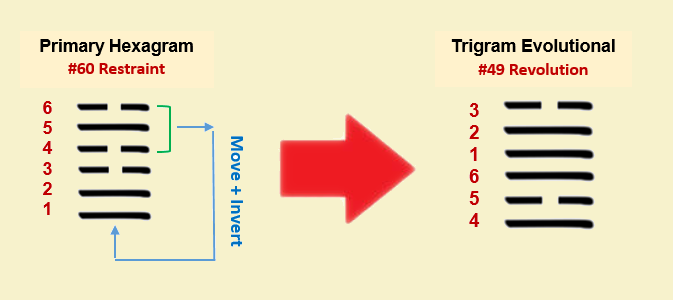
In its operational essense, this transformation is a special extension of “traditional” single-line-evolutional transformation
applied to primary hexagram 3 consecutive times.
At the divination level, this transformation signifies a special change situation, when top trigram transforms to its
opposite and becomes a lower trigram of a new, transformed hexagram.
Trigram-Swap Hexagrams
In this swap transformation the top and bottom trigrams exchange their positions in hexagram,
retaining the lines in trigrams as they are, i.e. line types and their relative order inside
each of trigrams remain intact.
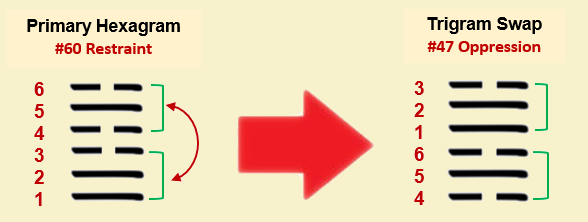
What does this change actually mean? Heaven and Earth changed their positions for good or for bad – you need to
analyze the upper-lower trigrams to understand transformed situation in all details.
Note also, that on a Trigrams level a swap transformation always produces the same target hexagram as a Trigram-Rotate!
Trigram-Flip Transformation
This transformation type was discovered by Stephen Karcher and originally discussed in all details in his book ([3], p. 55),
where it was called “rotation” or “inversion”. We call it here “flip-transformation” which we believe more accurately
describes the essence of what this operation actually does.
To get trigram-flipped hexagram simply flip primary hexagram on its central axis:
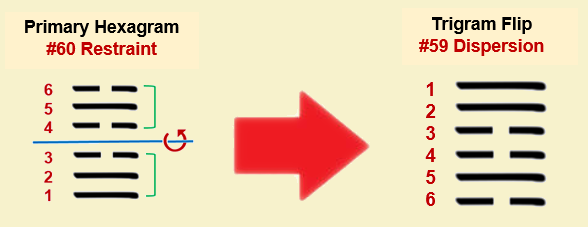
As you can see from this diagram, applying a trigram-flip operator produces well-known and discussed above
Reversed Hexagram!
Time reverses back in flipped hexagram – what was a beginning is now the end – it is complete reversal of time
in primary hexagram and in the life situation it describes.
Trigram-Flip-with-Inverse Transformation
This change-reach transformation brings described above trigram-flip operation to a new, much higher level – in addition to
flipping trigrams horizontally it logically inverts all lines in trigrams converting their Yins to Yangs and Yangs to Yins respectively.

Time flow not only reverses in this transformation, but flipped trigrams get transformed to their opposites.
This signifies a dramatic change. For example, for above hexagram #60 – Restraint,
flip-with-inverse transformation produces hexagram #55 – Abundance which has also
two other names - Receiving the Mandate and Opportunity.
How fundamentally different are the life situations denoted by these two hexagrams !
Summary
Summarizing results of monogram-, digram- and trigram-level transformations and presenting each level as the individual orbit,
we will have another insightful picture of primary hexagram and its transformational dependents.
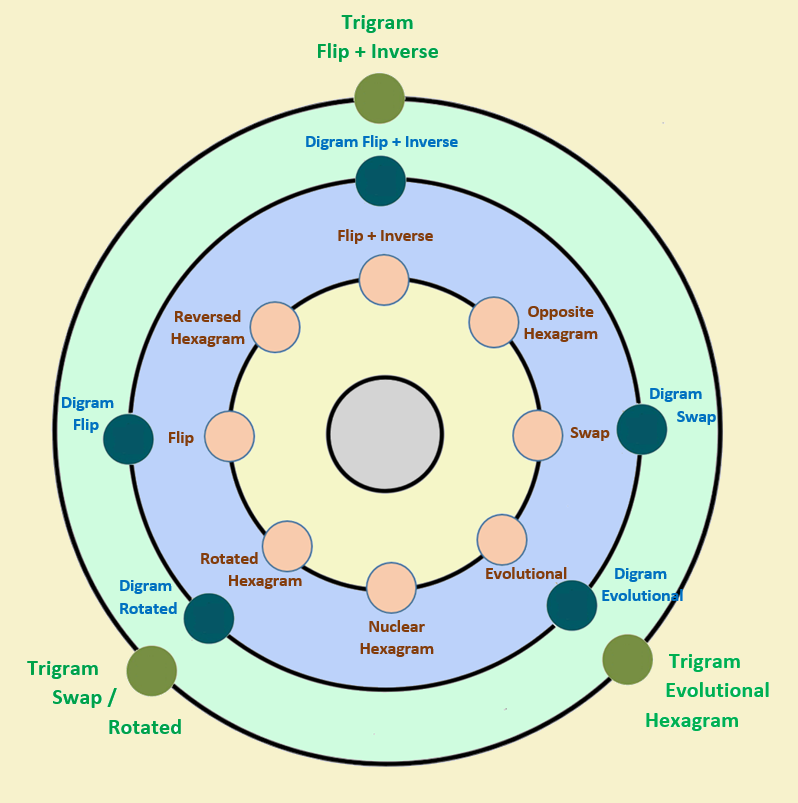
As I Ching is a cosmic level teaching, we will call this diagram a Big Orbit –
it depicts a “planetary” model of all discussed here hexagram transformation where a primary hexagram plays a role
of Sun and individual transformed hexagrams becoming the “planets” revolving around the center of Galaxy.
Additional Transformations
Discussed above hexagram transformation are the valuable modern tool in understanding I Ching answers to your questions
and can be applied to every hexagram in I Ching.
There is another, also very important group of hexagram transformations, which can be applied only if your casted hexagram
has the moving lines. These new transformations are based on the concept of Yin-Transformed and Yang-Transformed hexagrams
discovered by Stephen Karcher [3], as well as on the concept of Anti-Hexagrams originally discussed by Jane Schorre and
Carrin Dunne [12] and coined and popularised by Russell Cottrell.
These new hexagram transformations are discussed in more details in the Moving Lines page of this web portal.
Resonance and Invariance in Hexagram Transformations
In addition to the structural transformations described above,
certain hexagrams exhibit distinctive relational properties within their Big Orbit.
These are classified as Resonant or Invariant hexagrams:
- Resonant Hexagrams respond in a predictable way to specific transformation families, revealing structural affinities across different layers of the hexagram. They highlight recurring patterns of similarity that emerge across different transformation families, such as flips, swaps, or rotations.
- Invariant Hexagrams remain unchanged under one or more transformation operations, marking a stable core within an otherwise dynamic orbit. These hexagrams act as structural anchors, helping to clarify the essential configuration of a hexagram’s internal architecture.
Hexagram #11 — Related Resonant and Invariant Hexagrams
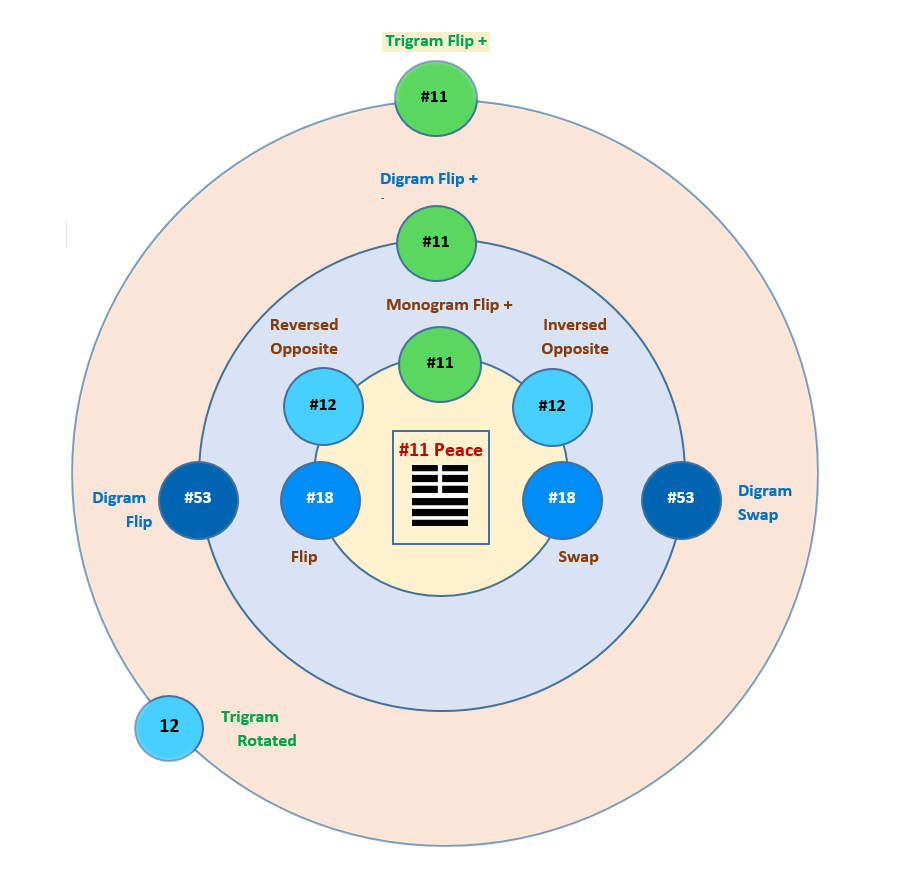
Resonant Groups for Hexagram #11
- Group 1: Hexagram #12 — Standstill
- Group 2: Hexagram #18 — Corruption
- Group 3: Hexagram #53 — Development
Reflect on the transformation results shown here: what structural patterns
does Hexagram #11 — Peace share with its resonant hexagrams #12 — Standstill,
#18 — Corruption, and #53 — Development?
Some transformation operations yield identical results.
When multiple transformation paths lead to the same hexagram, they are treated here
as identical transformations, reflecting structural convergence rather than redundancy.
This visualization allows you to see at a glance how specific hexagrams are
structurally connected, emphasizing both recurring patterns (resonance) and
points of stability (invariance) without displaying the full Big Orbit,
which includes all possible transformations.
Invariant Transformations for Hexagram #11
If resonance reveals how a hexagram echoes through related forms, invariance reveals where transformation returns to itself, exposing the stable axis within change.
For Hexagram #11, all three Flip+ transformations—Monogram-Flip+, Digram-Flip+, and Trigram-Flip+ — return the original hexagram unchanged.
This rare structural behavior identifies Hexagram #11 as an invariant center — an axis of stability within the broader field of hexagram transformations.
 Join Now !
Join Now !